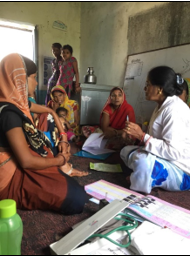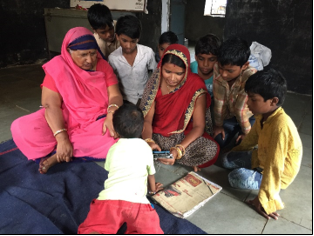


As a student of public policy, the Antara Foundation held a lot of promise because of their approach of building solutions that are can be scalable and sustainable. This would mean that every intervention envisions the foundation working with the government and eventually institutionalizing the solutions it builds. Furthermore, the fellowship offered an opportunity to be on the field, something which was sorely missing from my otherwise sanitized and academic experience.

Primary Health Centre, Dahikhera (Khanpur Block)
For the fellowship, I am placed in the field office located in Jhalawar, Rajasthan. It was an interesting time to be in Rajasthan as the hot sun gave way to clouds full of rain. I was assigned to work on the pilot of the Rajsangam App in the Khanpur block of the district. The work itself was pretty straightforward- I was to assist with the rollout of the app, work on improving the use and adoption rates as well as monitor its progress. The app was the online avatar of the existing AAA platform pioneered by TAF in partnership with Tata Trusts and the Government of Rajasthan.
The catch, for us was that we were asking more of the already pressed frontline workers. An Anganwadi worker (AWW) in the state of Rajasthan has to maintain eleven registers in addition to providing hot cooked meals and take home rations. An Accredited Social Health Activist or ASHA must maintain a diary, counsel pregnant woman and eligible couples, provide Home Based Newborn Care (HBNC) in addition to making ten household visits a day to access their health status. An Auxiliary Mid Wife (ANM) on the other hand is responsible for providing primary healthcare services to the villages which fall under the purview of her Sub Centre, in addition to performing Ante-Natal Check-ups on pregnant women and administering immunization. These three frontline workers, together make the AAA platform.

Village Health and Nutrition Day, Banskhera
In this scenario, the AAA workers would seemingly have no incentive to now work on an app. I expected to encounter roadblocks every day with frontline workers outright refusing to work on the app but surprisingly, that was not the case. What was lacking in most Anganwadi centres and sub-centres was adequate training and close supervision of the work.
Over the last three months, I have spent time in centres largely handholding front line workers as they worked through the app. Hands-on training helped build confidence of the frontline workers with the app. Many of them had not used the app since the training sessions in May. This meant that post-May, there was a drop in the data being fed into the app. In some of the rarer cases that meant starting from the very basics and going further behind and teaching them the basics of the register. On being given individual guidance on the app workflow and how it eliminates the double entry of data which exists in the registers, the frontline workers seemed more open to giving the app a try.
Everything is however not as rosy and the three months have revealed challenges that face us as we move ahead with the rollout. First, the moment we let go and there is a gap between two AWC visits, the app use falls short. Second, on encountering a bug or any unfamiliarity within the app the frontline workers immediately stop using that function of Rajsangam and finally, poor network and connectivity issues means that the data from the app does not get synced until someone from the foundation visits the centre. While the second of these challenges can easily be dealt with more stable and better builds, the first and the third one is concerning especially from a scaling standpoint. As one of the countermeasures, the team introduced the app to the supervisors which would be the first step to institutionalising the process. To date this has shown some limited success wherever the supervisor was hands on and followed up with the frontline workers. In Dahikheda, the sector that I am responsible for, the ASHA Supervisor is one such case and asks to see the claim form in the tablet during the monthly sector meetings. The ASHAs in the sector, probably half-afraid of their claims for work done not being approved, fill their HBNCs at the very least. Connectivity for now is being handled by making regular visits to centres. A silver lining is that some of the frontline workers have not only asked to be taught how to sync the data, they even manage to do it on their own.

Going ahead with Rajsangam would require us to adapt to these changes to tackle the problem of lack of motivation and even possibly develop an incentive structure as the app scales up, while addressing connectivity issues. These challenges are interesting, especially from a policy point of view and I hope to engage with them more deeply in the months to come.
Mahadevan Nambiar was a fellow with the Antara Foundation
Disclaimer: The article has been written in personal capacity, and the views and opinions expressed are those of the author